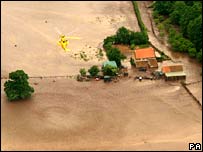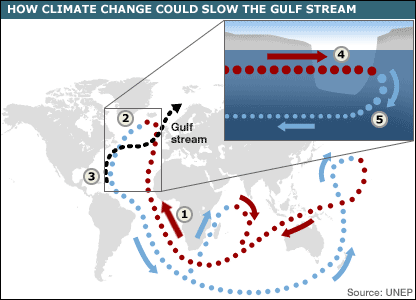|
|
 |
|
This report courtesy from the BBC on 1st March 2006. By Roger Harrabin We thought we would po this one up as it may vanish from bbc if Bush has his way! The global scientific body on climate change is expected to report soon that emissions from humankind are the only explanation for major changes on Earth. The Intergovernmental Panel on Climate Change (IPCC) formerly said greenhouse gases were "probably" to blame. Its next draft report will be sent to governments next month. The BBC has learnt the report will state that greenhouse gas emissions are the only explanation for changing patterns of weather across the world. It will say rising concentrations of gases such as carbon dioxide in the atmosphere must be the cause of simultaneous freak patterns in sea ice, glaciers, droughts, floods, ecosystems, ocean acidification and wildlife migrations. A source said: "The measurements from the natural world on all parts of the globe have been anomalous over the past decade. "If a few were out of kilter we wouldn't be too worried because the Earth changes naturally. But the fact that they are virtually all out of kilter makes us very concerned." He said the report would forecast that a doubling of greenhouse gas concentrations in the atmosphere would bring a temperature rise of 2C-4.5C or maybe higher. This would be a narrower range than contained in the last report, which suggested that the rise could be as little as 1.4C or as large as 5.8C. Uncertainties remain The scientists will say there is still great uncertainty about the pace and scope of future change. The doubling of CO2 from pre-industrial stable levels (270 parts per million) is expected to happen around the middle of the century.
A recent scientific report commissioned by the UK government warned that the world may already be fixed on a path that would begin melting the Greenland ice cap. That in turn would start raising sea levels throughout the world. There will be sceptics, predominantly in the US, who will accuse the IPCC of trying to scare policy-makers into action with their report. But the broad international expert consensus embodied in the IPCC will make it harder for the US administration to say that climate change is a problem for the future which can be solved by technological advances. In a meeting with climate campaigners, the UK Prime Minister Tony Blair said the world needed to engage the Americans, Chinese and Indians in agreement over a figure for CO2 stabilisation. But this is unlikely to happen while President Bush is in office; his representative told the December climate conference in Montreal that the US would not agree any targets for reducing CO2. President Bush's chief adviser James Connaughton said recently that it was pointless discussing a safe CO2 level as we could not be sure how resistant the world would be to greenhouse gases. Maybe we could double CO2 with impunity, or maybe we could increase it threefold or fourfold; the issue was not worth discussing, he said. Targets and timetables needed Mr Blair echoed President Bush's call for new technologies to combat climate change. But both men were told by international business leaders last year that more expensive new technologies would not supplant cheap dirty technologies unless governments set binding targets and timetables for reducing greenhouse gases, which the US has rejected.
BBC News has been told that the central policy in the review, the CO2 cut for big business, is still being contested, with the prime minister's industry adviser Geoffrey Norris urging a more lax target than the one demanded by the environment department Defra. Central figures in the review process are now admitting that the 20% target will be virtually impossible to hit, and are looking for a "respectable" near miss. The definition of "respectable" is still under ferocious debate.
|
|
Triftgletscher in Switzerland until recently filled the entire basin seen here. Thinning of the tongue during the 1990s accelerated and as of 2001 a lake started to form in front of it. Rapid break-up of the snout is now underway. Image: Glaciers Online/Jürg Alean
|
|
1 Surface currents carry warm, salty water from the tropics.
Gulf Stream Dramatic temperature shifts have happened in the past, driven partly by changes in a major ocean currents. A "great ocean conveyor" helps transport heat around the globe via surface and deep-sea movements of water. Scientists are exploring whether global warming might slow or shut it down - a scenario considered "low probability, high impact". This could disrupt mostly wind-driven surface currents such as the Gulf Stream, which brings milder weather to Northern Europe. Response from Dr Sherwood. As the world warms up due to an increase in gaseous content made up mainly of C02, the exponential curve begins to have an effect. At the start it will only show minor change which most people would become lethargic about and in many cases other scientists as well. However once the curve begins unless you start plotting the curve through a process of extrapolation by analysing the start of the curve the computer model would then give a startling result. As co2 gases take time to rise to the higher levels the results you see now and for the next 3 - 4 years are the gases that were released 40 years ago. So as we look at how these gases increased from there and extrapolate the results, well lets just say you don't want to know. Mr Bush and others are blinded by the early curve results as well as his scientific advisors. WAKE UP GUYS! It's time to dance! As for the gulf stream it is aready melting the southern polar region by melting the seabed ice which most of the Ross ice shelf was resting on and as it now has nothing to sit on it breaks up under its own weight! Then drifts north and melts. This would not raise the sea level as it is seabed ice. Landbed ice is different, it will increase the sea level due to displacement. Seabed ice will not cause displacement as it is aready in the ocean so is already a part of its mass. Landbased ice is not, so add it and the sea level will rise. The same principle applies to the Greenland ice sheet and also water from glacial flows that were iced up but are not anymore due to increasing atmospheric air temperatures. So taking all that into consideration we have a scenario for disaster unless something is done now and not later. 10 Years ago we said the ozone was worse than others predicted and it came to pass. We say the same for co2 and its effects. Only this time if you wait and see by the time you find out it will be too late! And if I know my maths and saturation points for co2 we are way beyond the threshold and in danger territory. When will the release happen of stored co2? Well that has already started!
|
|
(c) Copyright 1993-2008 Publishing |
| [Home] [Main index] [Environment] [climate change] |



